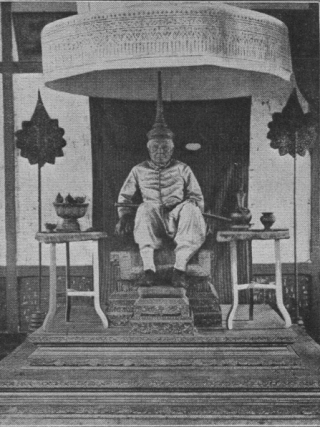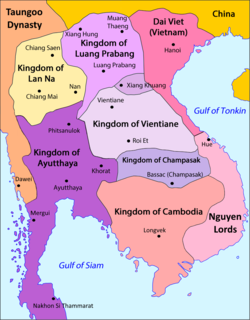
Laos, officially the Lao People's Democratic Republic, is a socialist state and the only landlocked country in Southeast Asia. At the heart of the Indochinese Peninsula, Laos is bordered by Myanmar and China to the northwest, Vietnam to the east, Cambodia to the southeast, and Thailand to the west and southwest. Its capital and largest city is Vientiane.

Evidence for modern human presence in the northern and central highlands of Indochina, that constitute the territories of the modern Laotian nation-state dates back to the Lower Paleolithic. These earliest human migrants are Australo-Melanesians—associated with the Hoabinhian culture—and have populated the highlands and the interior, less accessible regions of Laos and all of South-east Asia to this day. The subsequent Austroasiatic and Austronesian marine migration waves affected landlocked Laos only marginally and direct Chinese and Indian cultural contact had a greater impact on the country.

The Lao Kingdom of Lan Xang Hom Khao existed as a unified kingdom from 1353 to 1707.

King Sisavangvong Born Prince Khao(ຂເ-ົາ), was one of the last kings of Luang Prabang ruling from 28th of April 1904 until his death on the 29th of October 1959. According to Lao customs, while being crowned khao would be given a Courtesy name Sisavangvong and be addressed by his courtesy name until his death.

Luang Phabang, or Louangphabang, commonly transliterated into Western languages from the pre-1975 Lao spelling ຫຼວງພຣະບາງ as Luang Prabang, literally meaning "Royal Buddha Image", is a city in north central Laos, consisting of 58 adjacent villages, of which 33 comprise the UNESCO Town Of Luang Prabang World Heritage Site. It was listed in 1995 for unique and "remarkably" well preserved architectural, religious and cultural heritage, a blend of the rural and urban developments over several centuries, including the French colonial influences during the 19th and 20th centuries.

Prince Phetsarath Ratanavongsa (Somdej Chao Maha Uparaja Petsaraj Ratanavongsa was the 1st Prime Minister of Luang Phrabang in French Laos from 21 August 1941 to 10 October 1945, and Head of State of Laos between 12 October 1945 and 4 April 1946.

Sisavang Vatthana or sometimes Savang Vatthana was the last king of the Kingdom of Laos and the 6th Prime Minister of Laos serving from 29 October to 21 November 1951. He ruled from 1959 after his father's death until his forced abdication in 1975. His rule ended with the takeover by the Pathet Lao in 1975, after which he and his family were sent to a re-education camp by the new government.

Meuang Phuan or Xieng Khouang, also known historically to the Vietnamese as Trấn Ninh, was a historical principality on the Xiang Khouang Plateau, which constitutes the modern territory of Xiangkhouang Province, Laos.

The flag of Laos consists of three horizontal stripes, with the middle stripe in blue being twice the height of the top and bottom red stripes. In the middle is a white disc, the diameter of the disc is 4⁄5 the height of the blue stripe. The flag ratio is 2:3.

KingZakarine was the King of Luang Prabang from 1895 to 1904.

The Royal Palace in Luang Prabang, Laos, was built in 1904 during the French colonial era for King Sisavang Vong and his family. The site for the palace was chosen so that official visitors to Luang Prabang could disembark from their river voyages directly below the palace and be received there. After the death of King Sisavang Vong, the Crown Prince Savang Vatthana and his family were the last to occupy the grounds. In 1975, the monarchy was overthrown by the communists and the royal family were taken to re-education camps. The palace was then converted into a national museum.

The French protectorate of Laos was a French protectorate in Southeast Asia of what is today Laos between 1893 and 1953—with a brief interregnum as a Japanese puppet state in 1945—which constituted part of French Indochina. It was established over the Siamese vassal, the Kingdom of Luang Prabang, following the Franco-Siamese War in 1893. It was integrated into French Indochina and in the following years further Siamese vassals, the Principality of Phuan and Kingdom of Champasak, were annexed into it in 1899 and 1904, respectively.

Oun Kham was King of Luang Prabang during 1868-1887 and a second time between 1889 and 1895. The last two years of his reign ended with the establishment of a French protectorate over Laos. When unable to hold off outlaw Chinese Black Flag Army forces, he sought assistance from Rattanakosin for help. When the Siamese army left in 1887, the band of the White Tai pirate Deo Van Tri had overwhelmed Luang Prabang, which made Oun Kham seek refuge at Pak Lay. On 7 June 1887 the Lao royal capital was seized and sacked; the elderly ruler barely escaped with his life. Between his two ruling periods he was exiled in Bangkok where he gave assistance to Auguste Pavie.
Queen Kham-Oun I, was queen consort of Laos from 1904 to 1915 by marriage to king Sisavang Vong. She was the mother of Sisavang Vatthana. She died at the Royal Palace, Luang Prabang.

The Lao Issara was an anti-French, nationalist movement formed on 12 October 1945 by Prince Phetsarath. This short-lived movement emerged after the Japanese defeat in World War II and became the government of Laos before the return of the French. It aimed to prevent the French from restoring their control over Laos. The group disbanded in 1949.

Vientiane is the capital and largest city of Laos. Vientiane is divided administratively into 9 cities with a total area of only approx. 3,920 square kilometres and is located on the banks of the Mekong, close to the Thai border. Vientiane was the administrative capital during French rule and, due to economic growth in recent times, is now the economic center of Laos. The city had a population of 1,001,477 as of the 2023 Census.

Kingdom of Vientiane was formed in 1707 as a result of the split of the Kingdom of Lan Xang. The kingdom was a Burmese vassal from 1765 to 1824. It then became a Siamese vassal until 1828 when it was annexed by Siam.

Luang Prabang is a province in northern Laos. Its capital of the same name, Luang Prabang, was the capital of the Lan Xang Kingdom during the 13th to 16th centuries. It is listed since 1995 by UNESCO as a World Heritage Site for unique architectural, religious and cultural heritage, a blend of the rural and urban developments over several centuries, including the French colonial influences during the 19th and 20th centuries. The province has 12 districts. The Royal Palace, the national museum in the capital city, and the Phou Loei Protected Reserve are important sites. Notable temples in the province are the Wat Xieng Thong, Wat Wisunarat, Wat Sen, Wat Xieng Muan, and Wat Manorom. The Lao New Year is celebrated in April as The Bun Pi Mai.


















